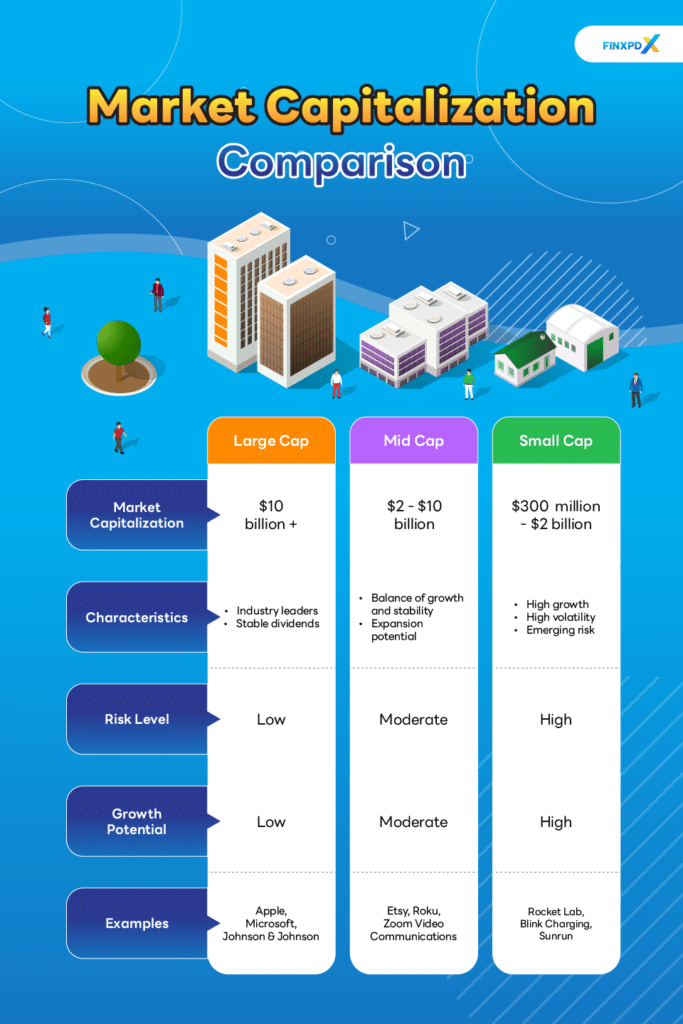If you’re new to investing, you might have heard about the term “large cap stocks” and wondered what it means. They are shares in big companies. Many people think they’re safer to invest in, but they have their pros and cons. In this article, we’ll explain the definition, how they work, and how they’re different from other investments.
What Are Large Cap Stocks?
Large cap stocks, also known as large capitalization stocks, refer to shares of companies with a high market capitalization. These companies are often well-established, dominant groups with a proven performance and stability track record. Due to their substantial size and influence, large cap companies tend to have more predictable earnings and are often considered safer investments than smaller companies.
Key Takeaways
- Large cap stocks are shares of companies with a market capitalization of $10 billion or more, known for their stability and established market presence.
- Large cap stocks offer stability, regular dividends, lower volatility, strong financial health, market leadership, global presence, significant R&D investment, and attract institutional interest.
- Large cap stocks may have lower growth potential compared to small or mid-cap stocks, and they might be less agile in responding to market changes.
- Companies are divided into 3 categories based on market capitalization which are small-cap, mid-cap, and large cap.
- Investing in large cap stocks offers stability, accessibility to information, high management quality, and regular dividends, making them a safe and reliable choice for long-term investments.
Features of Large Cap Stocks
Large cap stocks have several key characteristics that make them attractive to investors. These features show why big, established companies are often considered reliable investments.
Stability
Large cap stocks are known for their stability. These companies have established business models and steady income, making their performance more predictable. This stability is reassuring for investors, especially during market ups and downs.
Dividend Payments
Many large cap companies regularly pay dividends to their shareholders. These dividends provide a consistent income, appealing to investors seeking steady returns. Regular dividends also indicate the company’s financial health.
Lower Volatility
Large cap stocks usually have lower volatility than small-cap and mid-cap stocks. Their large market presence and diverse operations help them endure market fluctuations, offering a safer investment option.
Strong Financial Health
Large cap companies generally have strong balance sheets, significant cash reserves, and easy access to funding. This financial strength helps them weather economic downturns and invest in growth opportunities without risking their stability.
Market Leadership
Large cap companies often lead their industries. Their dominant market positions allow them to set industry standards and influence market trends. This leadership provides competitive advantages that support long-term growth and profitability.
Drawbacks of Large Cap Stocks
Large cap stocks are not perfect, they also have downsides. Some big company limitations can impact investment outcomes. Thus, these drawbacks are factors to consider for a better outcome:
Slower Growth
Big companies are usually already well-established, which can limit their growth compared to smaller businesses. Investors might not see the same rapid capital gains they would see with small-cap stocks.
Reduced Agility
Due to their size, big companies can be slower to adapt to market changes and new trends. This can be a disadvantage in industries that evolve quickly.
Higher Price Tags
Large cap stocks often come with higher price tags because of their stability and proven track record. This can make them more expensive and lower the overall return on investment.
The Differences Between Large Cap, Mid Cap, and Small Cap
Market capitalization, or market cap, is a metric that categorizes companies based on their total market value. This categorization divides companies into three primary groups: small-cap, mid-cap, and large cap. These classifications help investors understand a company’s relative size and make informed decisions about their investment strategies.

Why Should You Invest in Large Cap Stocks
Here are some advantages of investing in large cap stocks that you should know before making an investment decision:
Stability
When you invest in this kind of stock, you’re essentially putting your money into big, stable companies. These are generally safe chances for long-term investment, but remember that they won’t shield you from market fluctuations. Moreover, they might not be a good choice if you like to take a higher risk for big returns.
⚠️Tips: Although large cap stocks are stable investments, some risks might occur.
Accessibility
If you’re looking into large cap stocks, you’ll have much information at your disposal. These big companies have been around for a while, so it’s simpler to study their growth and stock price history. It can make them less risky than smaller companies.
Management Quality
Leadership is important, especially in large cap companies where industry experts fill top positions. So, when you see a seasoned professional in the top position, you can feel more confident that the company has a solid growth plan.
Dividend Distribution
For those aiming for a balanced portfolio, this type of stocks are often the good choice because these big companies usually offer regular dividends, which can offset smaller gains you might get from investing in smaller companies.
Conclusion
Large cap stocks usually offer stability and are less risky than small-cap stocks, which makes them a good choice for long-term investment. These stocks often offer steady growth and pay dividends to investors. However, if you’re looking for a dependable investment, they are one of the interesting choices.
FAQs
Large cap stocks are shares in big companies that have a market value of more than $10 billion.
Since there are many choices that people choose to trade, the most popular include Apple and Amazon.
A large cap stock is a company that has a value of more than $10 billion, which is stable and moderate growth. However, the value of mid-cap and small-cap stocks is smaller and also has higher risk.
They are considered to be less volatile, making them suitable for long-term investment strategies. However, it can cause a risk like other stock trading.
Related Articles:
Read more: Stocks








